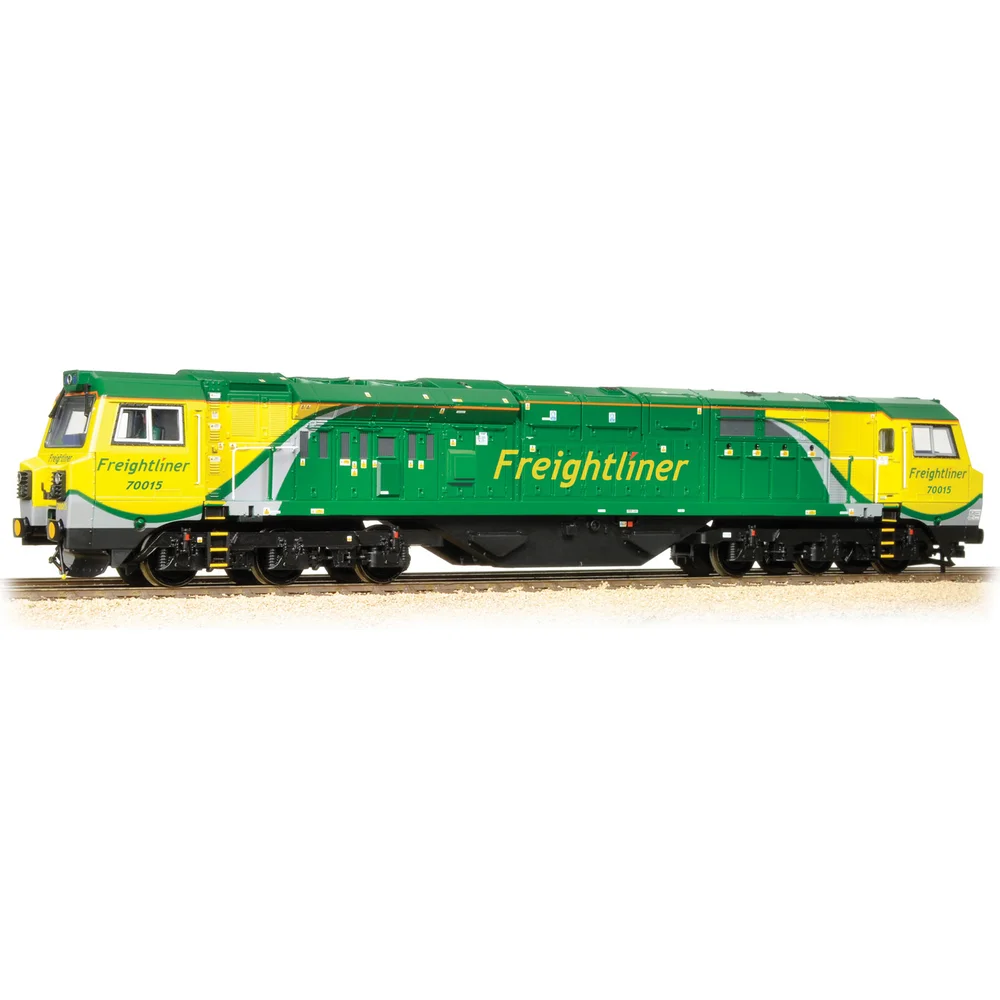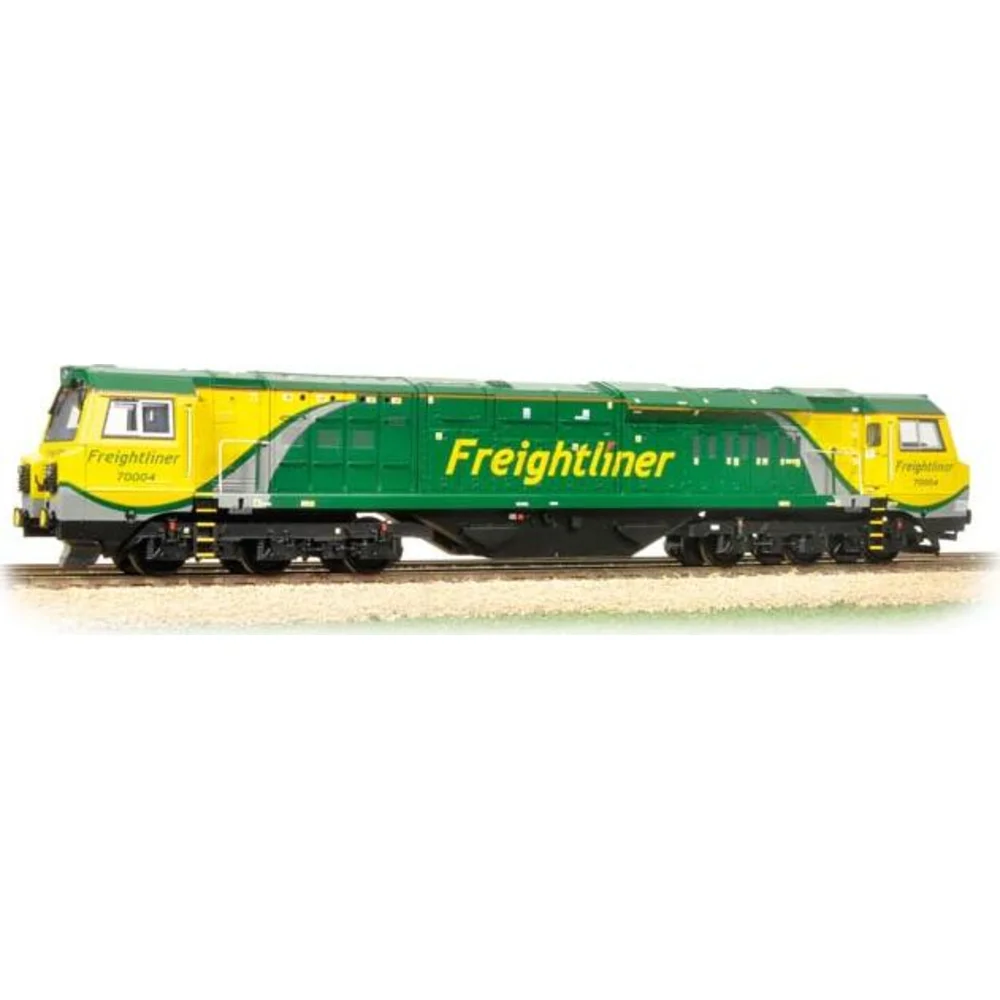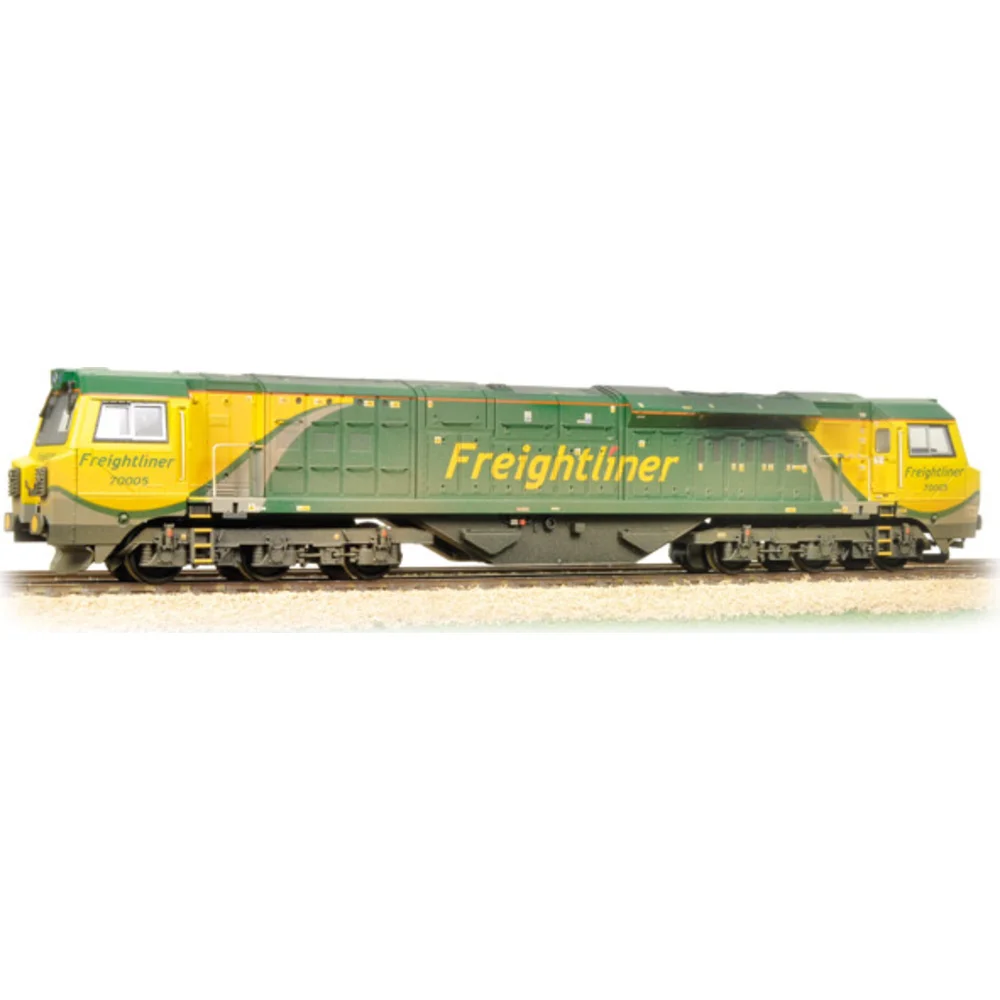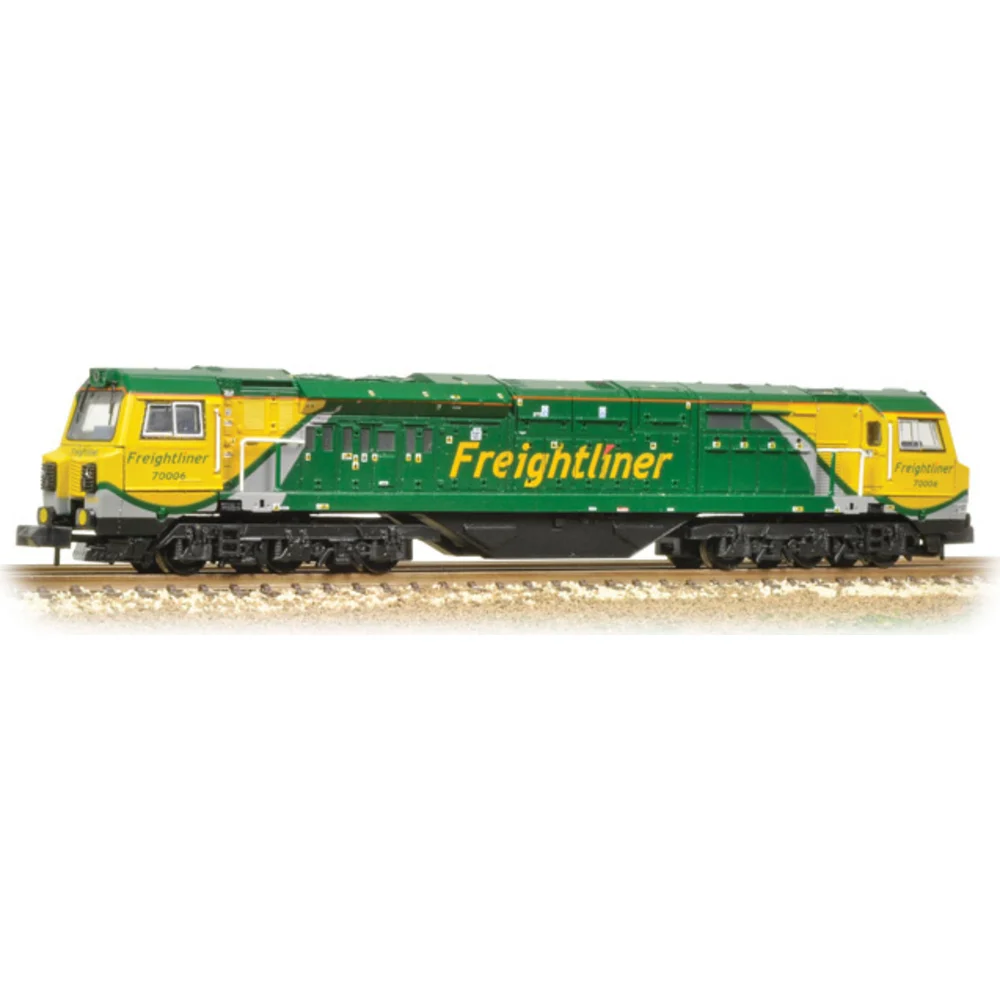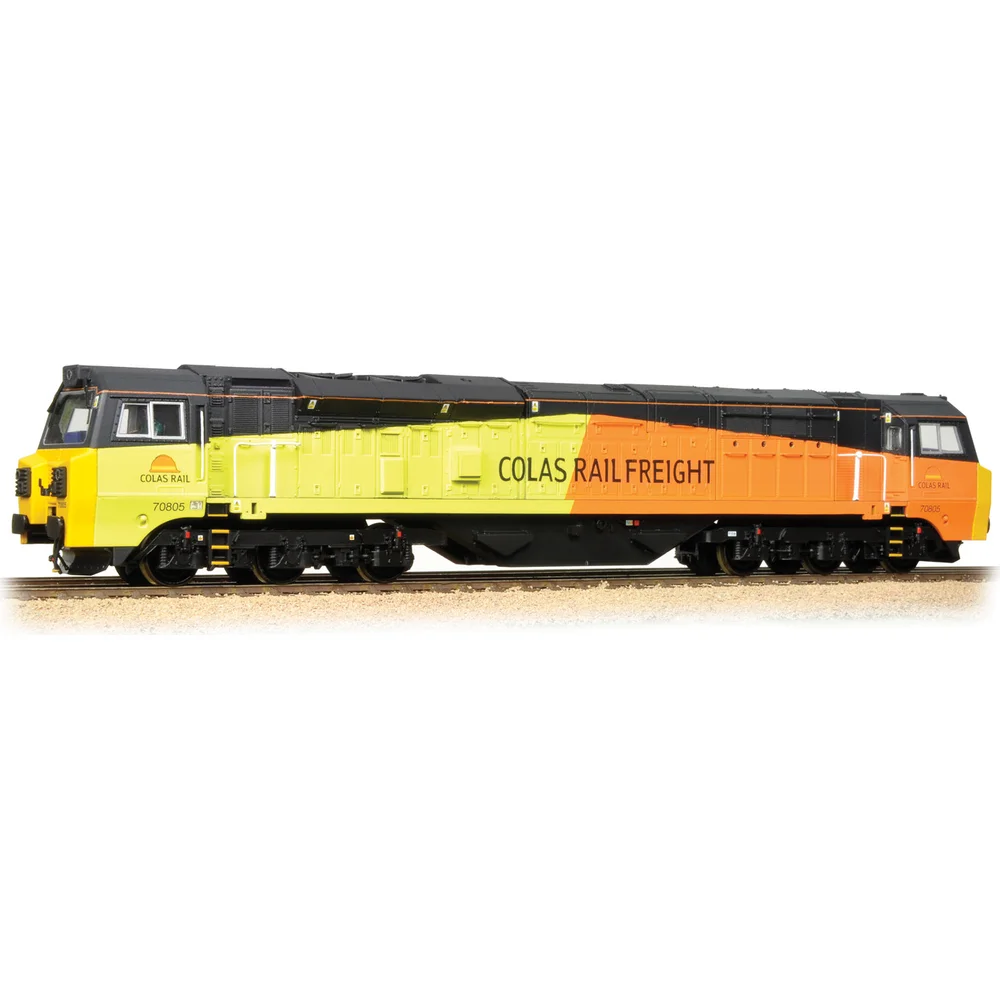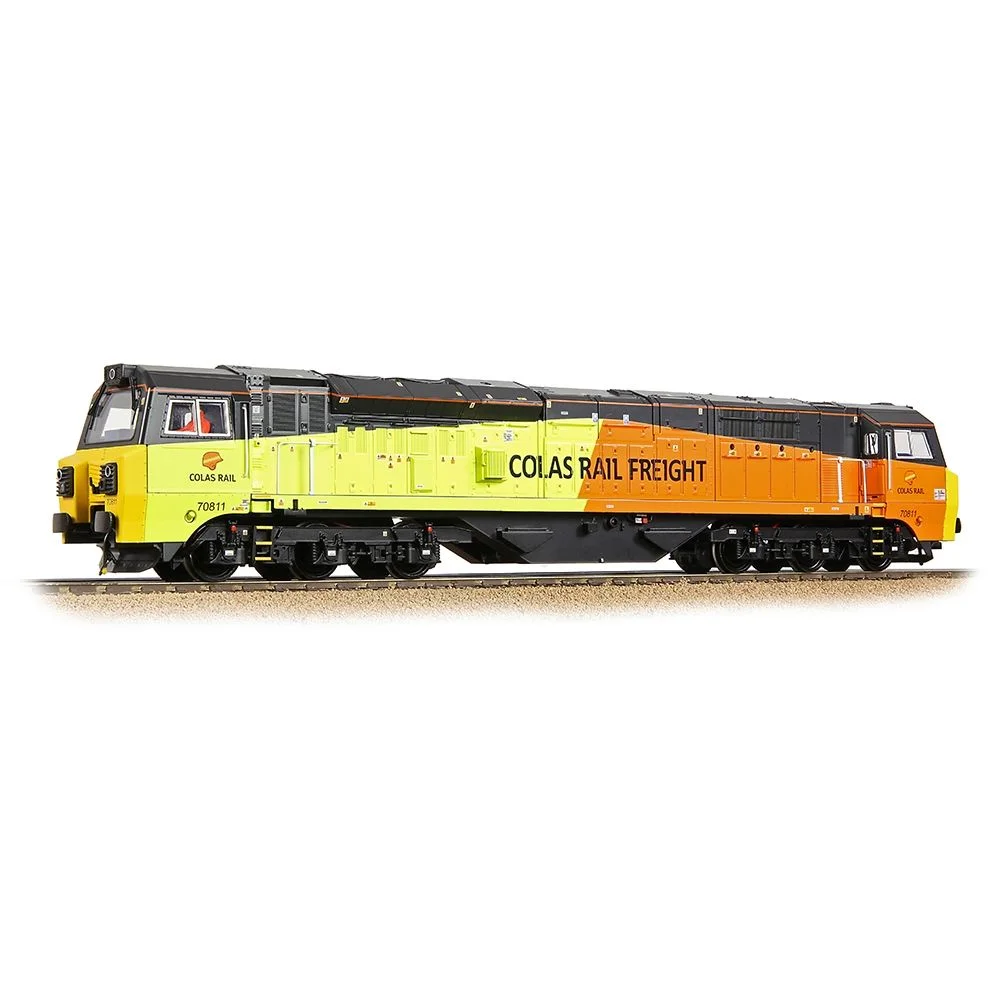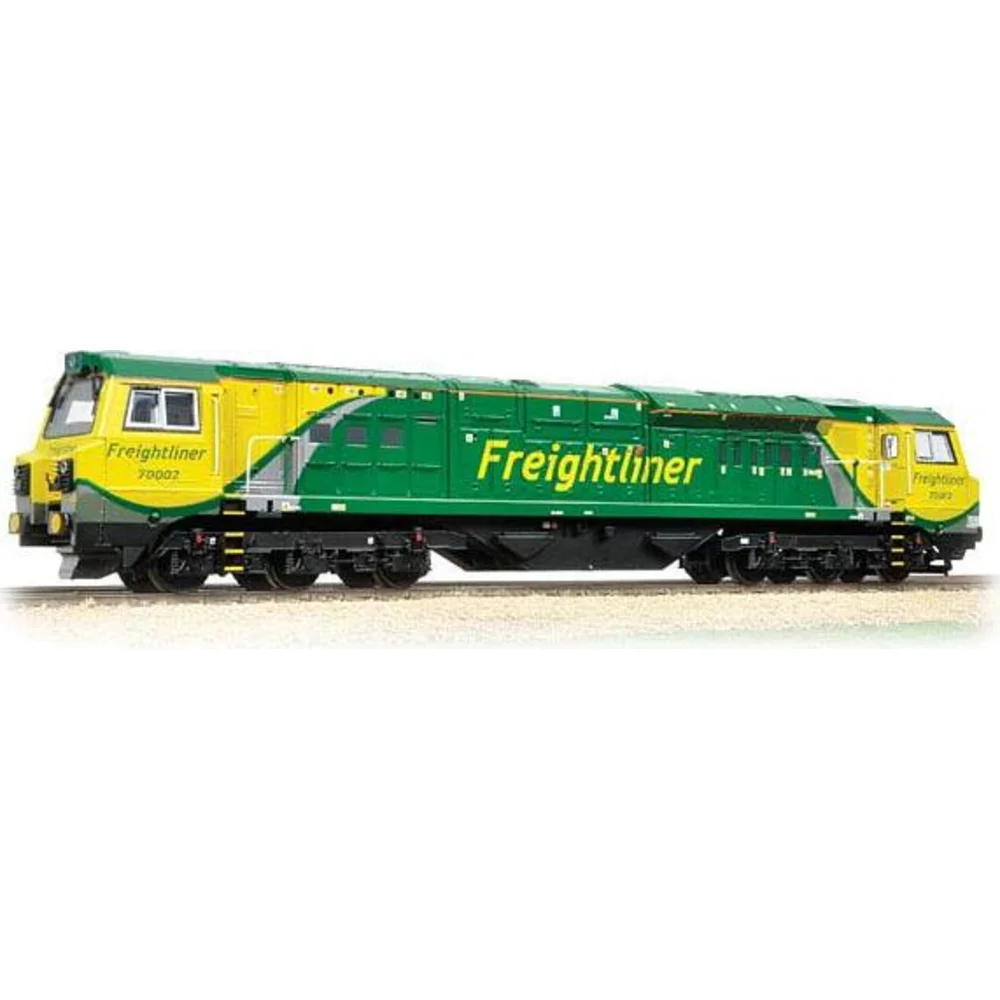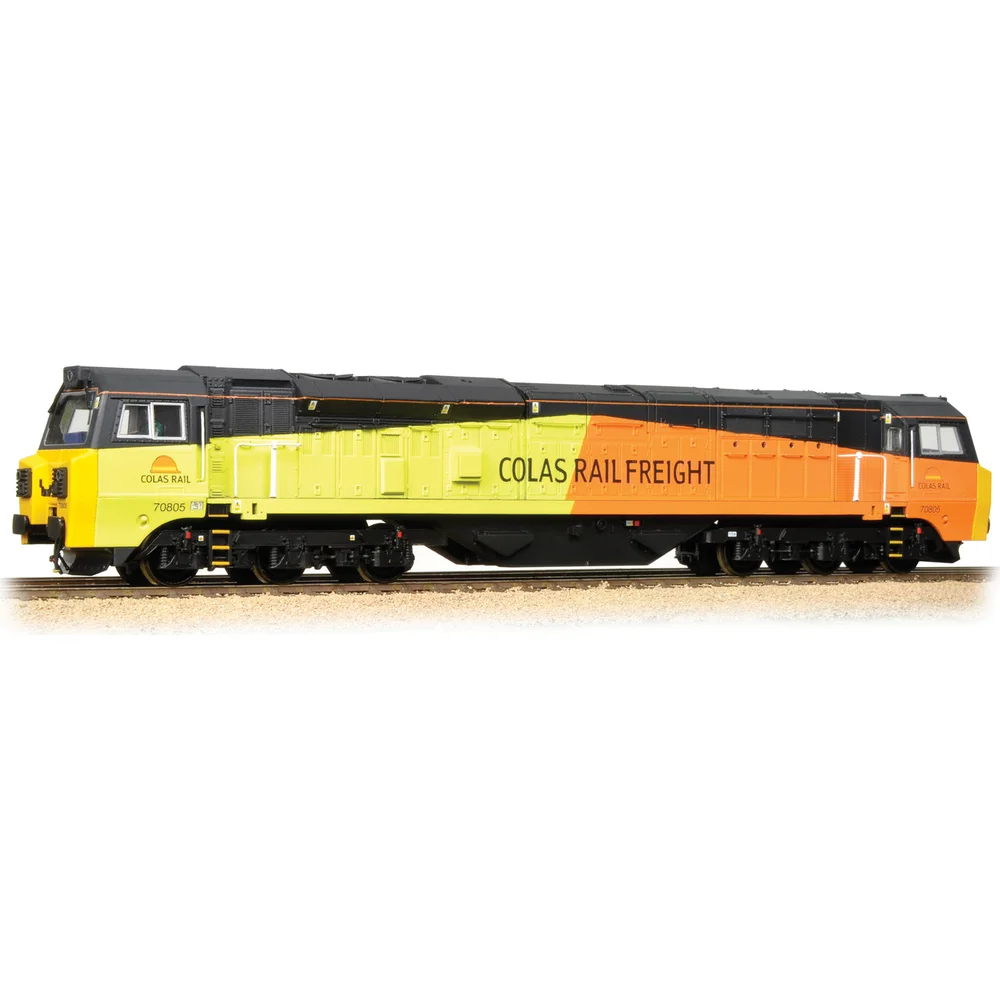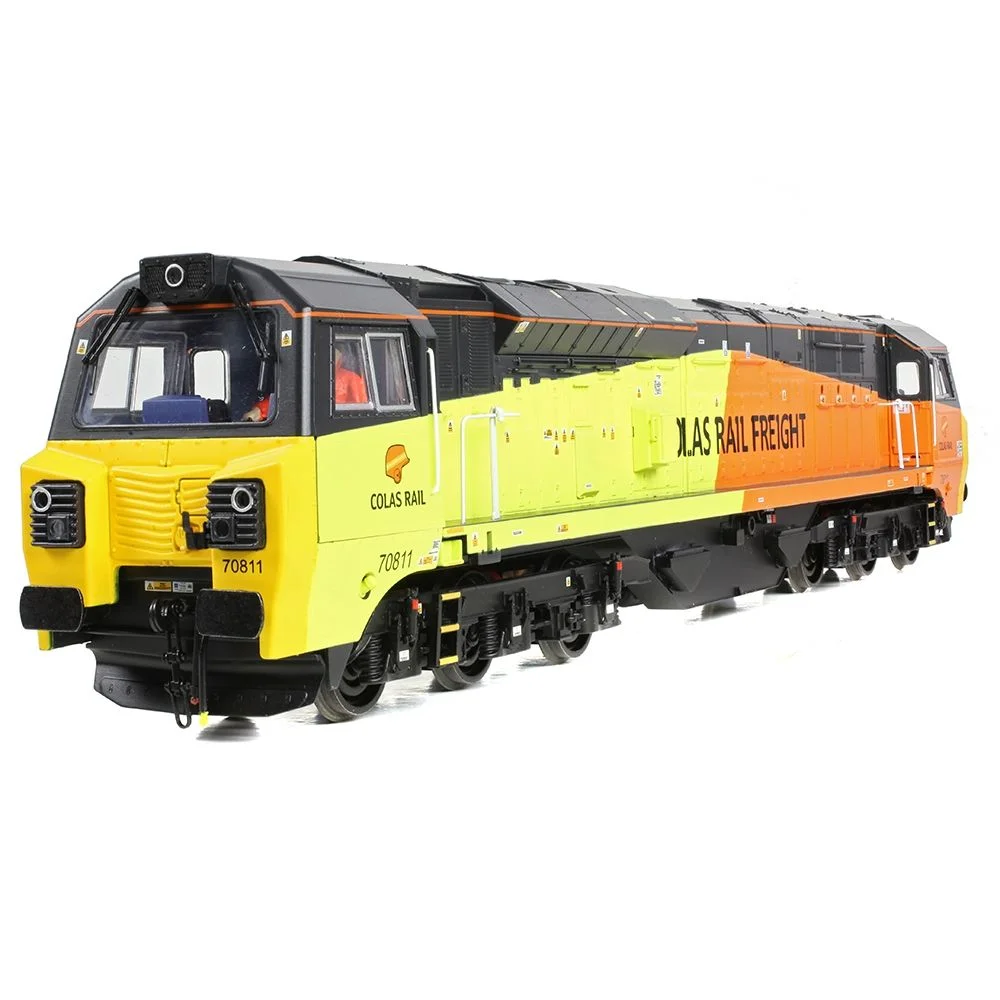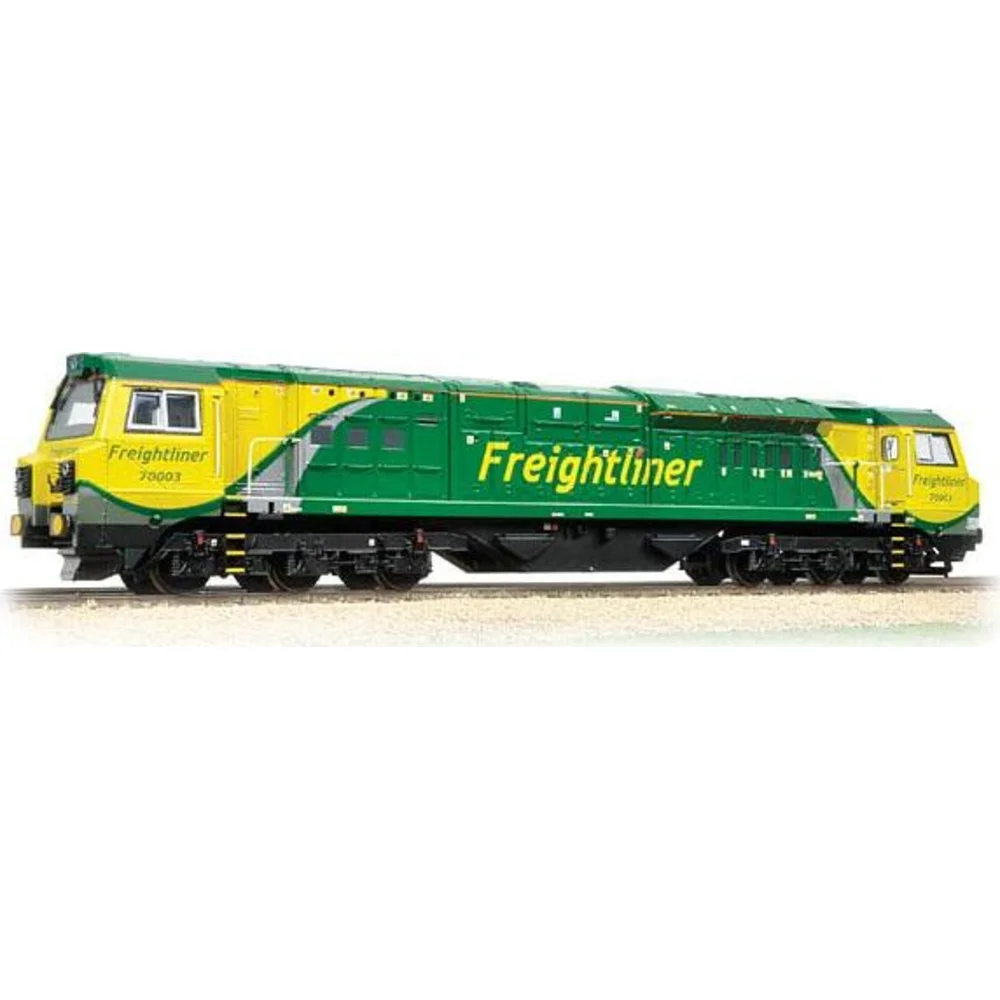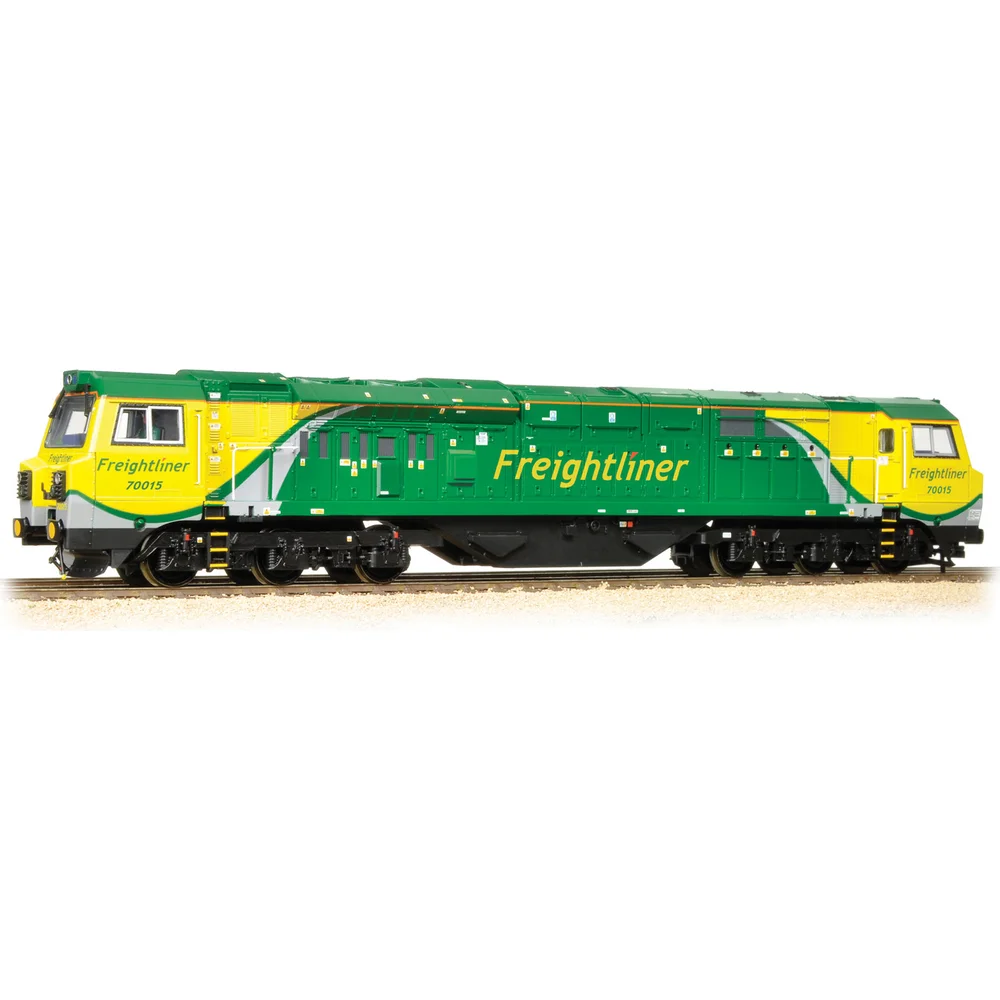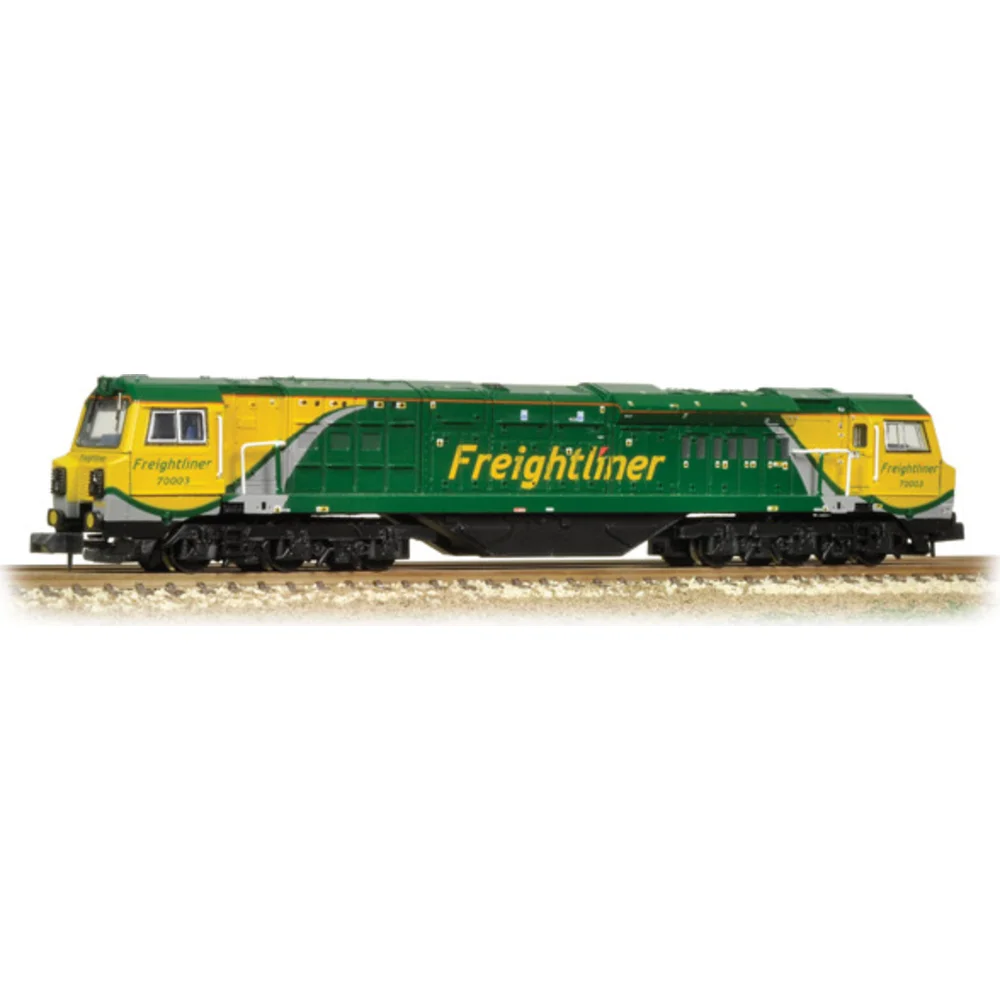British Rail Class 70 – PowerHaul Revolution in UK Freight Operations
Contents
The British Rail Class 70 represents General Electric's boldest entry into the UK freight locomotive market—a 3,690 horsepower diesel-electric powerhouse that promised revolutionary fuel efficiency, emissions compliance, and driver comfort when introduced in 2009. Built at GE's legendary Erie, Pennsylvania plant on the proven PowerHaul platform, these distinctive American-influenced hood units brought 544 kN of starting tractive effort to British rails, replacing aging Class 56 locomotives whilst challenging the ubiquitous Class 66's dominance. Thirty-six locomotives entered service across Freightliner Heavy Haul and Colas Rail between 2009 and 2017, introducing regenerative braking technology, air-conditioned cabs, and Miller cycle engine efficiency to UK operations.
For model railway enthusiasts, the BR Class 70 offers compelling modern-image prototype appeal with distinctive angular styling, diverse operational scenarios from intermodal container trains to 4,000-tonne aggregate flows, and comprehensive model availability through Bachmann's exclusive OO gauge range and Graham Farish N gauge offerings. The class's troubled early reliability history—with most Freightliner locomotives stored between 2017 and 2020—followed by remarkable resurgence hauling Peak District and Mendip aggregates creates fascinating operational narratives spanning the 2009-2025 period.
From initial introduction as Britain's most powerful privately-owned freight diesel through storage crises that threatened the entire concept, to ultimate vindication hauling record-breaking tonnages on quarry-to-London flows, the Class 70 demonstrates how modern locomotive technology must find its operational niche. The distinctive green-yellow Freightliner PowerHaul livery and bright Colas Rail yellow-orange colours ensure instant recognition, whilst special anniversary schemes celebrate heritage connections. With 33 of 36 UK-based locomotives operational as of October 2025, the PowerHaul has evolved from controversial newcomer to established heavy freight workhorse.
Quick Takeaways
- Thirty-six locomotives built: Freightliner ordered 20 locomotives (70001-70020) whilst Colas Rail acquired 17 units (70801-70817) including Turkish-built demonstrator, with construction spanning 2009-2017
- Most powerful private freight diesel: 2,750 kW (3,690 hp) GE PowerHaul engine delivers 13% more power than Class 66, with 544 kN starting tractive effort enabling 4,000-tonne aggregate train haulage
- Regenerative braking innovation: First British freight locomotives featuring energy recovery systems, converting braking energy to power auxiliary systems for improved fuel efficiency
- Storage crisis and recovery: Overheating problems caused 13 of 19 Freightliner locomotives to be stored by 2018, with full fleet storage by 2020 before Mendip Rail contracts enabled gradual return to service
- Aggregate operations dominance: Class 70s found their niche hauling heavy bulk trains from Tunstead and Merehead quarries, with single locomotives pulling Jumbo formations up to 4,000 tonnes
- Contrasting operator experiences: Colas Rail's 17 locomotives achieved excellent reliability from delivery with improved cooling systems, whilst Freightliner's early builds suffered availability problems until modifications implemented
- Comprehensive model availability: Bachmann holds exclusive OO gauge rights with multiple Freightliner and Colas liveries (£212-350 depending on specification), whilst Graham Farish produces N gauge variants (£150-175 RRP)
Historical Background and Context
The genesis of the Class 70 lay in Freightliner Heavy Haul's strategic assessment of Britain's aging freight locomotive fleet during the mid-2000s. By 2007, the company's operations relied heavily on Class 56 locomotives averaging over 30 years old with availability rates below 50 percent, supplemented by Class 66 locomotives that, whilst reliable, suffered from inadequate crew environments, excessive noise levels, and lack of climate control that contributed to documented driver hearing damage and fatigue. The business case for new traction became compelling when analysis revealed modern locomotives could deliver seven percent greater fuel efficiency whilst meeting progressively stringent EU emissions standards that would eventually prohibit older designs.
On November 26, 2007, Freightliner announced Project Genesis—Britain's largest private sector locomotive procurement at that time—committing £60 million for 20 General Electric PowerHaul locomotives with options for 10 additional units. This order represented General Electric's inaugural major locomotive contract for UK operations and marked the first order globally for the PowerHaul platform. The collaborative development process between Freightliner operations teams and GE engineers prioritised fuel efficiency through Miller cycle engine technology, emissions compliance meeting EU Stage IIIA standards, and dramatically improved driver working conditions addressing documented deficiencies in existing fleet designs.
General Electric's PowerHaul platform embodied sophisticated heavy-haul engineering principles refined through decades of North American freight operations. The core P616 engine derived from proven Jenbacher technology, incorporating twin turbochargers and high-speed operation at 1,500 rpm compared to competitors' 900 rpm designs. The innovative regenerative braking system—unprecedented in British freight locomotives—promised to recover energy during braking operations to power auxiliary systems, eliminating waste whilst contributing measurably to operational efficiency. The AC traction motor configuration with individual axle control delivered superior adhesion and wheel slip protection compared to earlier DC systems that plagued Class 56 operations.
The design specification incorporated unprecedented driver input regarding cab ergonomics and working environment. Freightliner driver representatives participated directly in cab layout development at Erie, resulting in full air conditioning systems, comprehensive acoustic insulation reducing noise levels from the Class 66's ear-damaging environment, left-of-center driving desks, and electronic "dial-less" displays replacing traditional analog gauges. These features addressed operator concerns about driver recruitment and retention in an era when younger employees increasingly expected modern working conditions comparable to road transport alternatives.
Insider Tip: Spotting Air Intake Modifications
The most visible external difference between early Freightliner and later Colas Rail locomotives involves the bodyside air intake modifications. Early Freightliner builds (70001-70020) featured flush-mounted intake grilles, whilst demonstrator 70099 received prominent raised intake boxes during Landore modifications addressing overheating problems. All subsequent Colas Rail production locomotives (70802-70817) incorporated these enlarged air intakes from construction, contributing to their superior reliability record. When modelling, ensure your Colas locomotives display these characteristic raised boxes—a crucial detail for period accuracy from 2014 onwards.
Construction commenced at General Electric's Erie, Pennsylvania plant in May 2009, with the facility's experienced workforce applying manufacturing techniques refined through decades of North American locomotive production. The first two locomotives, 70001 and 70002, completed construction in July 2009 and underwent three months of rigorous testing on American test tracks before shipment. They arrived at Newport Docks on November 8, 2009, with 70001 officially named "PowerHaul" at a ceremony in Leeds on November 24, 2009, marking the first General Electric locomotives in regular British freight service since pre-nationalisation imports.
Initial operational testing in December 2009 demonstrated impressive capabilities that validated Freightliner's procurement decision. Locomotive 70001 successfully hauled a 30-wagon intermodal formation carrying 60 ISO containers, whilst 70002 pulled a 1,300-tonne coal train with reserves of power. These trials confirmed the PowerHaul's substantial performance advantages over aging Class 56 locomotives whilst demonstrating capabilities exceeding even the successful Class 66 in heavy-haul applications. Deliveries continued steadily through 2010 and into 2011, though tragedy struck on January 5, 2011 when 70012 suffered catastrophic damage during unloading at Newport Docks. Lifting gear failure caused the locomotive to fall 13-20 feet back into the ship's hold, bending the frame beyond economic repair. The damaged unit was returned to Erie as a permanent test bed, never entering UK service.
Colas Rail's entry into Class 70 operations originated through General Electric's global marketing efforts. The Turkish railway administration ordered a demonstrator locomotive constructed at TÜLOMSAŞ in Eskişehir in February 2011, numbered 70099. After unsuccessful trials with GB Railfreight exploring potential orders, Colas Rail recognized the PowerHaul's suitability for their expanding infrastructure and freight operations. In November 2013, Colas committed to 10 locomotives including the demonstrator (to be renumbered 70801) plus four already-constructed units (70802-70805) from Freightliner's unexercised options, with construction of five additional locomotives (70806-70810) at Erie completing the initial order.
The demonstrator locomotive proved critically important to Colas Rail's subsequent operational success. During storage at Landore depot, engineers extensively modified 70099 addressing the overheating problems that plagued Freightliner's early fleet. The modifications included revised bodyside air intake configurations with prominent raised intake boxes dramatically improving cooling airflow. All subsequent Colas Rail production locomotives incorporated these modifications from construction, contributing directly to the Colas fleet's excellent reliability record that contrasted sharply with Freightliner's troubled early experience. Colas expanded their order in 2015, adding seven more locomotives (70811-70817) delivered through 2016-2017, bringing their total fleet to 17 units.
Design and Technical Specifications
The engineering excellence of the British Rail Class 70 derives from General Electric's systematic application of North American heavy-haul diesel-electric locomotive principles adapted for British loading gauge restrictions and operational requirements. At the core sits the GE PowerHaul P616LDA1 engine—a 16-cylinder, 60-degree V-configuration, twin-turbocharged diesel based on proven Jenbacher gas engine technology. This sophisticated powerplant operates at 1,500 rpm, 20 percent higher than contemporary competitors like the EMD 710's 900 rpm operational speed, enabling the high power density essential for packaging 2,750 kW (3,690 hp) within British gauge constraints.
The Miller cycle operating principle distinguishes the PowerHaul engine from conventional diesel designs. By closing intake valves early in the compression stroke, the Miller cycle reduces compression work whilst maintaining expansion stroke length, improving thermal efficiency and reducing peak combustion temperatures. This thermodynamic advantage delivers fuel consumption of 192-197 grams per kilowatt-hour at full load—significantly superior to competitors—whilst naturally reducing nitrogen oxide emissions. The engine meets EU Stage IIIA emission standards (Directive 2004/26/EC) without exhaust after-treatment, with pathways to Stage IIIB compliance through supplementary exhaust gas recirculation and diesel oxidation catalysts if regulatory requirements tighten.
The electrical system represents thoroughly modern AC traction technology contrasting with the DC systems of earlier British freight diesels. A GE GTA series alternator mounted directly to the engine produces three-phase AC power at variable frequency. Solid-state rectifiers convert this to an intermediate DC bus voltage, then individual IGBT inverters control each of six GE 5GEB30 AC axle-hung traction motors. This individual motor control architecture delivers superior adhesion management compared to earlier series-parallel DC systems, with sophisticated wheel slip detection immediately reducing power to slipping axles whilst maintaining maximum tractive effort on wheels with good adhesion. The technology eliminates the chronic wheelslip problems that plagued Class 56 operations.
The regenerative braking system—unprecedented in British freight locomotive design—captures otherwise-wasted kinetic energy during braking operations. When the driver applies dynamic braking, the traction motors operate as generators, converting rotational energy into electrical power fed back to the intermediate DC bus. This recovered energy powers auxiliary systems including compressors, cooling fans, and control electronics, reducing engine loading and fuel consumption. The system contributes approximately three percent additional fuel efficiency beyond the Miller cycle engine's inherent advantages, creating substantial operational cost savings over the locomotive's service life.
| Specification | Value |
|---|---|
| Power output | 2,750 kW (3,690 hp) at 1,500 rpm |
| Engine type | GE PowerHaul P616LDA1 16-cylinder Miller cycle diesel |
| Starting tractive effort | 544 kN (122,000 lbf) |
| Maximum speed | 75 mph (121 km/h) |
| Weight | 129 tonnes (tare) |
| Length | 21.71 metres (71 ft 3 in) |
| Width | 2.64 metres (8 ft 8 in) |
| Height | 3.92 metres (12 ft 10 in) |
| Wheel arrangement | Co-Co (all six axles powered) |
| Route availability | RA7 (highest UK freight category) |
| Fuel capacity | 6,000 litres (1,320 imperial gallons) |
| Emissions compliance | EU Stage IIIA (Directive 2004/26/EC) |
| Multiple working | AAR standard (compatible with Class 66/67) |
Physical specifications reflect the challenging compromise between North American hood unit design principles and British loading gauge restrictions. At 21.71 metres length and 2.64 metres width, the Class 70 squeezes substantial equipment into gauge L-A1-1806 parameters significantly tighter than North American loading standards. The characteristic narrow body hood with exterior walkways—creating the distinctive American appearance—results directly from this gauge constraint, contrasting sharply with the Class 66's center-cab configuration. The 129-tonne tare weight balances adequate mass for adhesion against infrastructure loading limits, distributed across six axles providing 21.5 tonnes per axle well within RA7 route availability specifications.
The carbody structure incorporates sophisticated crashworthiness features meeting EN 15227 standards through energy-absorbing zones in the nose sections. Reinforced steel fabrication creates the characteristic angular front end profile with prominent collision posts and anti-climbing features designed to prevent override during collisions. The hood contains the engine, cooling system, electrical cabinets, and air reservoirs, with removable panels facilitating maintenance access. The cab section provides crew accommodation with pressure-tested construction ensuring structural integrity whilst extensive sound insulation creates the quiet environment essential for long-distance freight operations.
Technical Innovation: The Regenerative Revolution
The Class 70's regenerative braking system represented genuinely revolutionary technology for British freight operations. Previous UK diesels dissipated braking energy as waste heat through resistor grids—Class 66 dynamic brake grids visibly glow red during sustained braking. The PowerHaul instead feeds this energy back to auxiliary systems, reducing fuel consumption whilst eliminating hot resistor maintenance. During typical operations, regenerative braking contributes three percent efficiency improvement—modest individually but substantial across annual operations. The technology anticipated by nearly a decade the battery-electric freight locomotives now under development, demonstrating GE's forward-thinking approach.
Cab environment represents perhaps the most dramatic improvement over preceding British freight diesels. Full air conditioning systems maintain comfortable temperatures regardless of external conditions—a revelation for drivers accustomed to the Class 66's sweltering summer conditions and inadequate heating. Comprehensive acoustic insulation including specialized engine compartment treatments, vibration-damped floor panels, and acoustic glazing reduces noise levels from the Class 66's documented hearing-damage levels to comfortable conversation volume. The left-of-center driving desk positions controls ergonomically, with electronic displays replacing analog gauges and providing comprehensive diagnostic information.
The fuel capacity of 6,000 litres balances operational range against weight constraints. Whilst smaller than the Class 66's 8,180-litre capacity, the PowerHaul's superior fuel efficiency delivers competitive range between refueling stops. The fuel system incorporates sophisticated filtration and water separation protecting the precision fuel injection equipment from contamination. Twin fuel pumps provide redundancy, whilst fuel preheating prevents waxing during winter operations. The exhaust system includes spark arrestors meeting UK safety standards whilst the silencer design minimizes external noise whilst maintaining backpressure within engine specifications.
Safety and control systems incorporate multiple protection layers. Automatic Warning System (AWS) provides audible and visual signals at distant signals requiring driver acknowledgment. Train Protection and Warning System (TPWS) automatically applies brakes when approaching signals at danger or exceeding speed restrictions. The locomotives came equipped with GSM-R communications and designed-in compatibility with European Train Control System (ERTMS) installation, positioning them for future signaling system evolution. Dead man's vigilance systems, cab secure interlocks, and comprehensive fault monitoring complete the safety architecture.
The cooling system proved critically important to operational reliability—as Freightliner's early fleet discovered through painful experience. The high power density powerplant generates substantial heat requiring dissipation through radiator sections mounted atop the hood. Thermostatically-controlled cooling fans draw air through filters and across radiator cores, with separate circuits cooling engine coolant, lubricating oil, and charge air from turbochargers. Early Freightliner builds suffered inadequate cooling airflow during sustained high-power operations, leading to overheating shutdowns. The revised air intake modifications fitted to demonstrator 70099 and all subsequent Colas Rail production locomotives addressed these deficiencies through enlarged intake openings and improved internal ducting.
Service History and Operations
The British Rail Class 70 entered revenue service in December 2009 with high expectations tempered by the inevitable challenges of introducing revolutionary new technology to conservative British freight operations. Initial deployments focused on premium intermodal services where the Class 70's superior power could justify higher operating costs compared to the proven Class 66. Freightliner assigned locomotives to their flagship Southampton Maritime to Midlands container trains, supplemented by diversified operations on coal flows, aggregates, and infrastructure trains demonstrating the fleet's versatility across diverse freight sectors.
Early operational experience revealed both capabilities and challenges. The PowerHaul locomotives demonstrated impressive pulling power on heavy formations, with drivers reporting excellent acceleration even with maximum-length container trains. The quiet, air-conditioned cabs received universal praise from crews accustomed to harsh Class 66 environments. However, technical problems emerged rapidly. Multiple engine room fires plagued early operations, most notably 70018's fire on April 5, 2012 between Basingstoke and Winchester requiring fire brigade attendance and causing extensive damage. Overheating problems became endemic, with locomotives suffering unexpected shutdowns during sustained high-power operations that proved particularly problematic on time-sensitive intermodal services.
The reliability crisis deepened progressively through the 2010s. By January 2017, Freightliner began storing Class 70s at Leeds Midland Road depot as availability rates plummeted and maintenance costs escalated. The storage programme accelerated dramatically: by July 2018, 13 of 19 locomotives sat idle awaiting expensive repairs with uncertain economic justification. The situation deteriorated further through 2019-2020, and by June 2020 virtually the entire Freightliner Class 70 fleet entered storage with only 70016 and 70017 maintaining sporadic service. This represented an operational disaster—less than 11 years after introduction with enormous capital investment, the entire fleet languished unused whilst reliable Class 66 locomotives handled the work originally intended for PowerHauls.
The Mendip Rail contract in 2019 provided unexpected salvation. Freightliner won the competitive tender for hauling aggregates from Somerset quarries operated by Aggregate Industries, with projections of eight million tonnes annually—heavy bulk traffic perfectly suited to the Class 70's high tractive effort and sustained power capabilities. Operational trials during July 2019 on Merehead-to-Acton aggregate trains demonstrated the locomotives excelled at this demanding work, with single Class 70s effortlessly pulling formations that would require Class 66 pairs or maximum-rated trains. The success prompted gradual fleet reactivation focused exclusively on aggregate operations.
Operational Insight: The 4,000-Tonne Jumbo Phenomenon
The Class 70's ultimate vindication came through "Jumbo" aggregate trains from Tunstead quarry in the Peak District to London terminals. These formations comprise 25-30 HTA aggregate hoppers grossing up to 4,000 tonnes—amongst the heaviest regular freight trains in Britain. Single Class 70 locomotives haul these monsters over challenging routes including the Hope Valley line's gradients, demonstrating the PowerHaul's remarkable capabilities. The trains operate under special authorization given their exceptional weight, with signaling and track occupation times calculated specifically for these flows. For modelers, recreating Jumbo operations provides authentic heavy-haul scenarios showcasing why the Class 70 survived its troubled introduction.
Progressive fleet reactivation continued through 2020-2021 as Freightliner refurbished stored locomotives specifically for aggregate work. Engineers implemented cooling system modifications informed by Colas Rail's successful operational experience, addressing the thermal management problems that plagued early builds. By March 2021, operational Class 70s achieved record monthly tonnages of 796,000 tonnes, vindicating the decision to preserve the fleet for heavy-haul applications rather than premature scrapping. As of October 2025, 16 of 19 Freightliner Class 70s operate actively on aggregate flows (70013, 70018, 70019 remain stored), with 70009 on long-term hire to Colas Rail since 2024.
Current Freightliner operations concentrate overwhelmingly on aggregates. Tunstead-to-Northampton and Tunstead-to-London services dominate, supplemented by Mendip Rail operations from Merehead quarry to Southeast England terminals. Regular diagrams include 4O14, 4O17, 4O18, 4O38, and 6B71 services, with secondary deployment on Southampton Maritime intermodal work and occasional port-to-Midlands container trains when aggregate operations permit spare capacity. The class has largely withdrawn from lighter intermodal duties where Class 66 reliability advantages and lower operating costs outweigh the PowerHaul's power benefits.
The Colas Rail operational experience contrasted dramatically with Freightliner's struggles. Benefiting from cooling modifications implemented from delivery and operated by crews experienced with diverse locomotive types, the Colas fleet achieved consistently excellent availability from the start. All 17 locomotives (70801-70817) remain operational as of October 2025, handling diverse work including Network Rail infrastructure trains during possession windows, aggregates movements complementing the operator's established flows, steel traffic from South Wales, timber trains (though reduced by 2025 as forestry traffic declined), and general engineering contracts across England, Scotland, and Wales.
Colas Class 70 operations span broader geographic territory than Freightliner's concentrated aggregate focus. Infrastructure trains for Network Rail engineering possessions form core business, with Class 70s hauling ballast trains, rail carriers, tamper movements, and engineering support trains nationwide. The distinctive Colas yellow-orange livery has become synonymous with weekend possession work, with enthusiasts regularly photographing Class 70s on diverse routes. Cross-country aggregates movements from Scottish and Welsh quarries supplement infrastructure work, whilst the long-term hire of 70009 from Freightliner since 2024 indicates healthy capacity requirements as Colas gradually reduces Class 56 deployment through their 2025 fleet rationalization programme.
Notable incidents punctuate the operational record, though remarkably few given the fleet's troubled reliability history. On February 27, 2016, Colas locomotive 70803 collided with an engineers' train at Ivybridge in Devon and derailed, though investigation attributed the accident to signaling irregularities rather than locomotive defects. October 30, 2016 witnessed 70804's runaway and derailment at Toton Sidings when securing systems failed during shunting operations—again, operational rather than fundamental design issues. January 28, 2020 brought a more serious incident when 70001-hauled container train 4O27 derailed at Eastleigh, though track defects rather than locomotive performance caused the derailment. All involved locomotives were repaired and returned to service, demonstrating the fleet's resilience despite operational challenges.
Recent developments include anniversary celebrations recognizing both Freightliner's corporate heritage and parent company Genesee & Wyoming's involvement. December 2024 saw 70008 emerge from refurbishment in retro green-yellow-white livery commemorating Freightliner's 60th anniversary, recreating the distinctive 1960s color scheme that characterized the company's pioneering containerization operations. Simultaneously, 70020 received orange-black Genesee & Wyoming 125th anniversary colors, celebrating the American shortline railroad company that acquired Freightliner in 2007. These special schemes generated significant enthusiast interest whilst maintaining the workaday fleet's focus on hauling Britain's aggregates and containers.
Fleet
| Ordered By | Built By | Built | Withdrawn | Length Of Service | Running Numbers | Names |
|---|---|---|---|---|---|---|
| Colas Rail | General Electric | April 2017 | 8.7 years | BR 70811 | ||
| Colas Rail | General Electric | April 2017 | 8.7 years | BR 70812 | ||
| Colas Rail | General Electric | April 2017 | 8.7 years | BR 70813 | ||
| Colas Rail | General Electric | April 2017 | 8.7 years | BR 70814 | ||
| Colas Rail | General Electric | April 2017 | 8.7 years | BR 70815 | ||
| Colas Rail | General Electric | April 2017 | 8.7 years | BR 70816 | ||
| Colas Rail | General Electric | April 2017 | 8.7 years | BR 70817 |
Freightliner Heavy Haul Class 70/0 (Numbers 70001-70020):
Built at General Electric's Erie, Pennsylvania plant 2009-2011, these 20 locomotives pioneered PowerHaul operations in Britain. As of October 2025:
- 70001 "PowerHaul" – Operational (first of class, named November 24, 2009 at Leeds)
- 70002-70007 – Operational
- 70008 – Operational (60th anniversary retro green-yellow-white livery from December 2024)
- 70009 – Operational (on long-term hire to Colas Rail from 2024)
- 70010-70011 – Operational
- 70012 – Withdrawn/Never entered UK service (damaged January 5, 2011 during unloading at Newport Docks, returned to Erie as permanent test bed)
- 70013 – Stored (Leeds Midland Road depot)
- 70014-70017 – Operational
- 70018 – Stored (Leeds Midland Road depot, suffered engine room fire April 5, 2012)
- 70019 – Stored (Leeds Midland Road depot)
- 70020 – Operational (Genesee & Wyoming 125th anniversary orange-black livery from 2024)
Effective Freightliner fleet: 19 locomotives (16 operational = 84.2% availability, 3 stored, 1 in USA as test bed)
Colas Rail Freight Class 70/8 (Numbers 70801-70817):
Built 2011-2017 at Erie, Pennsylvania (except 70801 built at TÜLOMSAŞ, Eskişehir, Turkey). All 17 locomotives operational as of October 2025:
- 70801 (ex-70099 demonstrator) – Operational (Turkish-built February 2011, originally for demonstrator trials, acquired by Colas Rail November 2013)
- 70802-70817 – All operational (standard Colas Rail yellow-orange-black livery)
Colas Rail achieved 100% fleet availability throughout operational history, with all locomotives receiving improved cooling modifications from delivery based on 70801 demonstrator experience.
Combined UK Class 70 fleet summary: 36 locomotives total (33 operational = 91.7% availability, 3 stored, 1 withdrawn/test bed in USA)
No Class 70 locomotives operate outside Britain. The demonstrator 70099 (later Colas 70801) was the only unit built outside Erie, with Turkish construction representing GE's unsuccessful attempt to establish PowerHaul production for European markets. No Class 70s have been exported, scrapped (except 70012's effective loss), or preserved as of October 2025.
Withdrawal and Preservation Legacy
The withdrawal history of the British Rail Class 70 remains largely unwritten, as 33 of 36 UK-based locomotives continue active operations as of October 2025. At ages ranging from 8 to 16 years, the fleet represents young traction by British diesel standards, with typical freight locomotive service lives extending 35-45 years under normal circumstances. The sole withdrawal—70012's catastrophic damage during 2011 unloading at Newport—occurred before the locomotive entered service, representing an accident loss rather than operational retirement. The three stored Freightliner locomotives (70013, 70018, 70019) remain serviceable and could return to traffic if business requirements justify refurbishment investment.
The UK government's commitment to railway decarbonisation and the 2040 diesel locomotive ban casts significant uncertainty over the Class 70's long-term operational future. By 2040, the fleet would age between 23 and 31 years—ordinarily mid-life for freight diesels with potential for 10-20 additional service years. However, regulatory restrictions on diesel operations may force premature retirement unless operators invest in alternative fuel conversions or the locomotives receive exemptions for non-electrified route operations. The substantial recent investment in Freightliner fleet refurbishment for aggregate work suggests operators anticipate at least 15 years additional service, implying operational lives extending into the mid-2030s.
Potential pathways for life extension include hydrotreated vegetable oil (HVO) biofuel adoption—trials already conducted on various British freight diesels demonstrate technical feasibility with minimal modifications. The PowerHaul's sophisticated fuel injection system tolerates HVO blends, potentially enabling carbon-neutral operations on non-electrified routes post-2040. Alternative scenarios include battery-electric hybrid conversion leveraging the existing electrical architecture, though the substantial weight and cost implications make this approach economically questionable. Export to overseas railways represents another possibility, with the PowerHaul platform operating successfully in numerous countries lacking Britain's aggressive decarbonisation timeline.
The engineering legacy proves more certain than physical preservation prospects. The Class 70 validated several design principles that influenced subsequent British freight locomotive development, particularly regarding driver environment standards that raised expectations across the industry. The regenerative braking technology anticipated battery-electric and hybrid locomotive developments by nearly a decade, demonstrating energy recovery concepts now fundamental to decarbonisation strategies. The collaborative design process between operator and manufacturer established precedents for future procurement programmes, with driver input recognized as essential for creating operationally successful locomotives.
Preservation prospects appear reasonably strong given the class's historical significance as General Electric's first UK freight locomotives and the operational drama surrounding their troubled introduction and subsequent recovery. Railway preservation societies typically prioritize historically significant or operationally distinctive locomotives, and the Class 70 satisfies both criteria. The distinctive American-influenced styling, powerful performance capabilities, and relatively young age make preservation more likely than for many contemporary diesel classes. Locomotive 70001 "PowerHaul"—first of class and the sole named unit of historical significance—represents the most probable preservation candidate, though its operational value to Freightliner for aggregate work may delay retirement beyond typical preservation timelines.
Preservation's Modern Opportunity
Unlike historic classes that faced extinction before preservation movement maturity, the Class 70 exists in an era when heritage railways actively acquire recent traction for operational diversity. The locomotives' 75 mph maximum speed suits main line charter operations, whilst substantial power enables impressive demonstration runs with heavy formations. The air-conditioned cabs provide crew comfort for long-distance movements between heritage sites. Modern components ensure parts availability and maintainability far superior to 1960s-1970s diesels. Most critically, the Class 70's operational story—from controversial introduction through storage crisis to aggregate renaissance—provides compelling narrative appeal that preservation interpretations can celebrate.
Several heritage railways maintain financial capacity and operational interest for Class 70 preservation. The Great Central Railway's focus on main line diesel operations, the East Lancashire Railway's diverse modern traction fleet, and the Severn Valley Railway's substantial diesel collection all represent potential preservation homes. Main line registered heritage operators including West Coast Railway Company or GB Railfreight's heritage operations might acquire operational examples for charter work, providing revenue service justifying preservation investment. The precedent of Class 66 preservation—with 66718 acquired by Nemesis Rail for heritage operations—demonstrates commercial viability for preserving recent freight diesels.
The timing of preservation activity likely falls in the 2035-2045 period as regulatory pressures or fleet replacement programmes withdraw operational examples. Early preservation candidates might include stored locomotives 70013, 70018, or 70019 if Freightliner determines refurbishment economically unjustifiable, though their lack of operational significance compared to 70001 reduces preservation appeal. The distinctive anniversary liveries on 70008 and 70020 create additional preservation interest, representing unique color schemes worthy of retention alongside standard PowerHaul livery examples.
Modelling Significance and Scale Replications
The British Rail Class 70 presents exceptional modelling significance as the most powerful privately-owned diesel locomotive in contemporary British freight operations, offering authentic modern-image traction for layouts depicting 2009-present operations. The distinctive American-influenced styling contrasts visually with indigenous British designs, creating immediate recognition whilst the operational diversity—from 4,000-tonne aggregate Jumbo trains to Network Rail infrastructure work—provides varied operational scenarios. For modellers committed to contemporary accuracy, the Class 70 represents essential motive power for realistic Freightliner Heavy Haul and Colas Rail freight operations alongside ubiquitous Class 66 locomotives.
The modelling landscape features comprehensive coverage in OO and N gauges through Bachmann's exclusive manufacturing rights, though notable gaps exist in larger scales. Hornby does NOT produce Class 70 models—a common misconception among enthusiasts—with Bachmann Europe holding exclusive production rights following detailed collaboration with Freightliner and Colas Rail providing access to technical specifications, livery standards, and operational insights. This exclusivity ensures consistent quality standards whilst protecting substantial tooling investment across multiple livery variants.
Bachmann Branchline OO gauge models represent the definitive Class 70 representation, with extensive development ensuring exceptional prototype accuracy. Announced in 2011 following the class's operational introduction, the first models reached enthusiasts in 2013, immediately earning acclaim for sophisticated detail levels, smooth operation, and comprehensive feature sets. The range encompasses multiple catalogue numbers organized into Freightliner PowerHaul and Colas Rail series, with periodic releases introducing additional livery variations and operational examples.
Technical specifications demonstrate serious engineering: a powerful 5-pole motor with twin flywheels drives all wheels through universal shafts and worm gearing to both bogies, providing exceptional pulling power and smooth crawling speeds. All-wheel electrical pickup from 12 nickel silver pickup strips ensures reliable operation on less-than-perfect track. The diecast metal chassis and substantial weight (approximately 350-370 grams depending on variant) deliver stability and realistic inertia. Models measure 288mm length, accurately representing the 21.71-meter prototype at OO's 1:76 scale. The 21-pin DCC decoder socket (NEM660 standard) positioned in the cab facilitates straightforward digital conversion.
Detail quality throughout impresses: separately-fitted metal handrails, lamp brackets, multiple working unit cables, vacuum brake pipes, and detailed brake rigging create visual depth absent from cheaper ready-to-run models. Factory-fitted glazing includes decorated cab interiors with driver figures, control desks, and instrument panels visible through windows. The machine room detail shows through hood side grilles. Etched metal fan grilles, precisely-rendered bogies with separately-fitted detail parts, and authentic buffer details complete the impressive specification. Colas Rail variants feature over 140 individual printed warning signs and safety notices—extraordinary attention to prototype accuracy.
Available OO gauge variants include:
Freightliner PowerHaul livery:
- 31-585: 70006 Freightliner PowerHaul green-yellow-grey (discontinued, original 2013 release, pre-owned £130-160)
- 31-585Z: 70001 Freightliner exclusive edition (limited retailer exclusive, rare, £180-220 when available)
- 31-588: 70005 Freightliner weathered finish (discontinued 2013 release, demonstrates authentic operational weathering, pre-owned £140-170)
Colas Rail Freight livery:
- 31-591: 70805 Colas standard (discontinued, represents early Colas operations without prominent air intakes, pre-owned £150-180)
- 31-591A: 70811 Colas with air intake modifications (current production, £249.95 RRP, typically £212-220 retail with discounts)
- 31-591ASF: 70811 Colas with factory-fitted DCC sound (current production, £349.95 RRP, typically £297-320 retail)
The 31-591A/ASF series represents the most accurate tooling, incorporating the characteristic raised bodyside air intake boxes fitted from 2014 onwards to address cooling problems. These prominent features distinguish later Colas Rail locomotives from early Freightliner builds, making the 31-591A essential for modellers depicting post-2014 Colas operations. Sound-fitted versions include authentic GE PowerHaul diesel engine recordings with realistic start-up sequences, running sounds at various throttle positions, horn, and auxiliary equipment sounds. Remarkably, sound models play engine start-up and shutdown sequences even on conventional DC analogue layouts, though full functionality requires DCC operation with 28/128 speed step control.
Performance characteristics suit heavy freight operations: the powerful motor and all-wheel drive deliver impressive haulage capacity, with models effortlessly pulling 25-30 wagons on level track—authentic for prototype Jumbo aggregate operations. Minimum curve radius of Hornby 2nd radius (438mm/17.25 inches) accommodates most OO gauge layouts, though 3rd radius (505mm/20 inches) or larger creates more prototypical appearance given the locomotive's 21.71-meter length. The substantial weight and low center of gravity prevent derailments during reverse running or coupling operations.
Graham Farish N gauge models provide comprehensive Class 70 coverage in 2mm scale, manufactured by Bachmann Europe under their N gauge brand. Models measure approximately 125mm length, accurately representing the prototype at N gauge's 1:148 scale. The mechanism features a coreless motor with twin flywheel drives, all-wheel drive transmission, comprehensive electrical pickup, and 6-pin DCC decoder socket (NEM651 standard). Detail includes etched metal fan grilles, factory-fitted glazing, and authentic livery application.
Available N gauge variants include:
- 371-635: 70006 Freightliner PowerHaul (£165.95 RRP, typically £141-150 retail)
- 371-636: 70003 Freightliner PowerHaul (similar pricing)
- 371-640: 70015 Freightliner with air intake modifications (2020 revised tooling, £169.95 RRP, typically £145-155 retail)
- 371-641: 70805 Colas Rail with air intake modifications (2020 revised tooling, £169.95 RRP, typically £145-155 retail)
The 2020 revised tooling (371-640/641) incorporates the characteristic air intake boxes, providing accurate representation of modified locomotives for contemporary operations. N gauge models perform reliably on 228mm (9-inch) radius curves, though 285mm (11.25-inch) or larger improves appearance. Recommended decoder installation uses Bachmann 36-558A 6-pin decoder or ESU LokPilot Micro V4.0 for superior motor control and advanced features.
O Gauge and Alternative Scales:
No O gauge (7mm scale, 1:43.5) Class 70 models exist from any manufacturer as of October 2025. Heljan's extensive British O gauge diesel range—covering Classes 20, 25, 26, 33, 35, 37, 40, 42, 45, 47, 50, 52, 55, and 60—notably excludes the Class 70, with no announcements suggesting future production. Tower Models, Dapol O gauge, and other specialist manufacturers similarly offer no Class 70 products. The substantial market size required for O gauge tooling combined with the class's relatively recent introduction and modest fleet size (36 locomotives) makes commercial production unlikely in the foreseeable future.
TT:120, Z gauge, and large-scale (G gauge/16mm scale) modellers face complete absence of Class 70 models. No manufacturers produce or have announced Class 70 representations in these scales. Custom 3D printing services theoretically could produce Class 70 models, though research identified no confirmed designs available through Shapeways, Thingiverse, or specialist 3D printing suppliers. Brass models and white metal kits remain unavailable, reflecting the class's modern origins and limited enthusiast base compared to heritage steam and early diesel types.
For O gauge modellers requiring modern freight traction, Heljan Class 60 (catalogue numbers covering all sub-classes and operators) or forthcoming Class 66 models provide contemporary diesel alternatives representing similar operational periods. The lack of Class 70 availability unfortunately creates a significant gap in O gauge modern image operations, though the practical difficulties of manufacturing commercially-viable models for a 36-locomotive prototype fleet in expensive O gauge format explain this absence.
Models
| Builder | Catalogue # | Year | Running # | Class, Operator (Livery) "Name" | Scale | Finish | Era | DCC |
|---|---|---|---|---|---|---|---|---|
| Bachmann | 31-585 | 2010 | 70006 | British Rail Class 70, Freightliner (Green & Yellow) | OO | P | 9 | DCC21 |
| Bachmann | 31-585Z* | 70001 | British Rail Class 70, Freightliner (Green & Yellow) "Powerhaul" | OO | P | 9 | DCC21 | |
| Bachmann | 31-586 | 2010 | 70003 | British Rail Class 70, Freightliner (Green & Yellow) | OO | P | 9 | DCC21 |
| Bachmann | 31-587DC | 2013 | 70004 | British Rail Class 70, Freightliner (Green & Yellow) | OO | P | 9 | DCCF |
| Bachmann | 31-587DS | 2012 | 70002 | British Rail Class 70, Freightliner (Green & Yellow) | OO | P | 9 | DCCS |
| Bachmann | 31-588 | 2013 | 70005 | British Rail Class 70, Freightliner (Green & Yellow) | OO | W | 9 | DCC21 |
| Bachmann | 31-590 | 2015 | 70015 | British Rail Class 70, Freightliner (Green & Yellow) | OO | P | 9 | DCC21 |
| Bachmann | 31-591 | 2015 | 70805 | British Rail Class 70, Colas Rail (Yellow & Orange) | OO | P | 9 | DCC21 |
| Bachmann | 31-591A | 2023 | 70811 | British Rail Class 70, Colas Rail (Yellow & Orange) | OO | P | 9 | DCC21 |
| Bachmann | 31-591ASF | 2023 | 70811 | British Rail Class 70, Colas Rail (Yellow & Orange) | OO | P | 9 | DCCS |
| Graham Farish | 371-635 | 2012 | 70006 | British Rail Class 70, Freightliner (Green & Yellow) | N | P | 9 | DCC6 |
| Graham Farish | 371-636 | 2012 | 70003 | British Rail Class 70, Freightliner (Green & Yellow) | N | P | 9 | DCC6 |
| Graham Farish | 371-640 | 2016 | 70015 | British Rail Class 70, Freightliner (Green & Yellow) | N | P | 9 | DCC6 |
| Graham Farish | 371-641 | 2016 | 70805 | British Rail Class 70, Colas Rail (Yellow & Orange) | N | P | 9 | DCC6 |
Unique Modelling Tips and Layout Integration
Successfully incorporating British Rail Class 70 models into layout operations requires understanding the specialized heavy freight and infrastructure roles that characterize prototype operations. Unlike general-purpose diesels suitable for diverse traffic, the Class 70 found its niche hauling maximum-capacity aggregate trains and supporting Network Rail engineering work—specific applications demanding appropriate operational scenarios, consist formations, and infrastructure representation for authentic atmosphere.
Era selection proves fundamental for Class 70 deployment. The earliest appropriate timeframe begins December 2009 when the first locomotives entered revenue service, though full fleet operations span 2010-2011 for Freightliner and 2014-2017 for Colas Rail deliveries. Layouts set 2009-2013 should show predominantly Freightliner PowerHaul green livery with emerging operational deployment on intermodal and coal traffic. The 2014-2020 period brings Colas Rail yellow-orange locomotives whilst Freightliner examples progressively enter storage—creating the paradox of declining Freightliner operations alongside expanding Colas deployment. Contemporary layouts (2020-2025) emphasize Freightliner aggregate renaissance alongside continued Colas infrastructure work, with anniversary liveries appearing from 2024.
Authentic Freightliner Heavy Haul operations center overwhelmingly on aggregate traffic from 2019 onwards. Typical scenarios include Tunstead quarry (Peak District) to Northampton/London services hauling 4,000-tonne Jumbo formations, Merehead quarry (Somerset Mendips) to Southeast England flows, and secondary aggregate movements from various quarries to construction terminals. The signature operation involves single Class 70 locomotives hauling 25-30 HTA or HYA aggregate hoppers—formations visually impressive and prototypically accurate for heavy-haul modeling. Earlier period operations (2010-2018) can depict intermodal container trains with FEA-B spine wagons or KFA container flats, coal trains with HTA hoppers, and mixed freight though these applications prove less characteristic than aggregate dominance.
Colas Rail operations span broader operational diversity suitable for varied layout scenarios. Network Rail infrastructure trains during engineering possession windows form core business—ballast trains with JNA hoppers, rail carriers (Salmon/Coalfish wagon types), tamper and regulator support movements, and engineers' tool vans create authentic infrastructure consists. General aggregates traffic from Scottish and Welsh quarries supplements possession work. Cross-country engineering trains moving materials between Network Rail depots provide long-distance operational justification. The yellow-orange Colas livery ensures instant recognition whilst the operational variety enables diverse operational sessions beyond repetitive aggregate cycles.
Weathering Authenticity for Modern Freight Operations
Class 70 weathering should reflect modern freight operations whilst acknowledging the locomotives' relatively young age (8-16 years). Focus weathering on operational areas: exhaust staining above engine room roof vents using diluted black-brown acrylics applied via airbrush, allowing color to drift over hood edges. Underframe and bogies accumulate rail dust and brake dust—Frame Dirt (Lifecolor UA719) or similar earth tones applied to entire underframe creates authentic grime. Body panels receive subtle dirt accumulation in panel lines around ventilation grilles using heavily-diluted washes, then manipulated with damp brush to create realistic streaking. Modern freight locomotives maintain reasonably clean appearance through regular depot washing, so restraint creates authenticity—avoid heavy industrial weathering inappropriate for locomotives receiving professional maintenance. The Bachmann weathered 70005 (catalog 31-588) provides factory reference for appropriate intensity.
Consist formations must match prototype practice and operational period. Freightliner aggregate trains comprise 19-30 HTA/HYA aggregate hoppers in Tarmac blue-grey, Hanson blue, or Aggregate Industries red-grey liveries—available from Accurascale, Dapol, and Revolution Trains in OO gauge, Graham Farish and Dapol in N gauge. Earlier period intermodal consists use FEA-B spine wagons (Accurascale/Revolution Trains) or KFA container flats (multiple manufacturers) loaded with 20ft, 40ft, and 45ft ISO containers in major shipping line liveries. Colas infrastructure trains require Network Rail yellow engineers' wagons, ballast hoppers, rail carriers, and support vehicles—sources include Bachmann, Dapol, Hornby, and Revolution Trains dependent on specific wagon types.
Train lengths should reflect the Class 70's substantial 544 kN starting tractive effort. Typical formations involve 20-30 aggregate hoppers (representing 3,000-4,500 tonnes loaded), 15-25 container flats on intermodal services, or 10-20 engineers' wagons on infrastructure trains. Single locomotive operation represents standard practice, with pairs appearing only on exceptional loadings or positioning movements. The models' powerful motors and all-wheel drive easily handle these formations on level track, though steep gradients may require operational compromises—prototypically, Tunstead-to-London Jumbo trains traverse challenging Hope Valley gradients demonstrating the PowerHaul's capabilities.
Layout infrastructure should reflect modern freight operational requirements. Aggregate loading facilities feature concrete batching plants, conveyor systems, and elevated loading hoppers characteristic of contemporary quarry operations. Container terminals require reach stackers, gantry cranes, and hardstanding areas for ISO container storage. Network Rail infrastructure trains stage in loops during engineering possession windows, requiring appropriate signaling (temporary speed restrictions, possession limit boards) and support infrastructure. Modern LED signal aspects, CCTV cameras, and security fencing create convincing contemporary atmosphere essential for Class 70 operations set in 2009-2025 period.
Sound-equipped models benefit from realistic programming reflecting the PowerHaul's operational characteristics. The GE P616 engine's high-speed 1,500 rpm operation creates distinctive sound profiles different from slower-revving competitors. Programme decoders to emphasize realistic operational sequences: gentle idling at terminals (Function 1 for engine start/stop), progressive throttle notching during acceleration (Functions 2-4 for horn, dynamic brake, sanders), steady running sounds during cruise, and dynamic braking during deceleration. The regenerative braking system creates unique sound signatures—motors operating as generators produce different frequency patterns than motoring. Authentic horn usage at level crossings and when approaching terminals adds operational realism.
Multiple-unit operation with Class 66 locomotives creates interesting operational scenarios prototypically observed when power requirements or operational convenience warrant. The AAR multiple-working system enables seamless operation between Class 66 and Class 70 types, with mixed consists appearing on particularly heavy aggregate trains or when locomotives reposition between duties. The visual contrast between Class 66's rounded center-cab profile and Class 70's angular hood-unit design creates striking photographic opportunities whilst remaining prototypically accurate.
Depot scenes provide excellent static display opportunities demonstrating maintenance infrastructure. Model Freightliner's Leeds Midland Road facility or Colas Rail's Cardiff Canton TMD with appropriate buildings, fueling points, maintenance workshops, and storage sidings. Class 70s sharing depot space with Class 56, Class 66, or Class 67 locomotives creates authentic fleet diversity. Include operational details: fuel tanks, wheel-cleaning equipment, inspection pits, parts storage containers, and depot staff figures engaged in maintenance activities. The storage crisis period (2017-2020) offers unique modeling opportunities showing multiple Class 70s stored out-of-use—challenging for operational layouts but fascinating for diorama representations documenting this troubled chapter.
Timetable construction for operating sessions should reflect intensive modern freight schedules. Contemporary operators maximize locomotive utilization through tight turnaround times and back-to-back workings. A typical Class 70 duty might involve departing Tunstead with loaded aggregates, arriving London terminal for unloading, returning light-engine or with empty hoppers, then commencing second loaded aggregate working—completing two revenue trips during an operating session. This intensive pattern reflects commercial realities whilst creating engaging operations for modelers who appreciate constant activity over leisurely pacing.
Finally
The British Rail Class 70 represents far more than 36 diesel-electric freight locomotives—these machines embody the challenges, innovations, and ultimate resilience that characterize modern railway operations in an era of rapid technological change and environmental imperatives. General Electric's PowerHaul platform brought genuine American heavy-haul engineering sophistication to British rails, delivering 13 percent more power than established competitors whilst pioneering regenerative braking, Miller cycle efficiency, and driver environment standards that raised industry expectations. The troubled introduction—with overheating problems, availability crises, and fleet storage threatening the entire programme—demonstrates how even thoroughly-engineered modern technology must find operational niches matching capabilities to applications.
For railway historians, the Class 70 story provides fascinating insights into contemporary locomotive procurement, operational deployment challenges, and the economic pressures shaping modern freight railways. Freightliner's £60 million Project Genesis gamble initially appeared disastrous as technical problems caused widespread fleet storage barely a decade after introduction. The salvation through Mendip Rail and Tunstead aggregate contracts—capitalizing on the PowerHaul's exceptional tractive effort for 4,000-tonne Jumbo trains—vindicated the original procurement whilst demonstrating how operational focus transforms struggling programmes into successes. Colas Rail's parallel experience achieving excellent reliability through cooling modifications proves that learning from early challenges enables subsequent fleets to avoid predecessor problems.
The contrast between Freightliner's troubled early operations and Colas Rail's consistently successful deployment illustrates how seemingly-identical locomotives perform dramatically differently under varied operational philosophies and technical specifications. The raised air intake modifications fitted to Colas locomotives from delivery—informed by demonstrator 70099's Landore modifications—created fundamental cooling improvements that should have been incorporated in original Freightliner builds. This engineering lesson underscores the importance of thorough prototype testing and willingness to implement modifications addressing identified deficiencies before series production.
The distinctive American styling—hood-unit configuration with exterior walkways, angular crashworthiness features, and characteristic GE proportions—ensures the Class 70 remains instantly recognizable amongst predominantly indigenous British diesel designs. The green-yellow Freightliner PowerHaul livery and bright Colas Rail yellow-orange colors create strong visual identity, supplemented by anniversary schemes celebrating corporate heritage. These locomotives brought North American freight railroad aesthetic to British operations, creating visual diversity that enhances railway enthusiast interest beyond purely operational considerations.
Bachmann and Graham Farish's comprehensive OO and N gauge model ranges enable contemporary railway modelers to recreate authentic Class 70 operations across multiple scales and operational scenarios. The exclusive manufacturing rights ensure consistent quality whilst the multiple livery variants spanning both operators and various operational periods provide choices suiting diverse layout themes and preferences. DCC Ready and Sound Fitted specifications address different technical sophistication levels and budgets, whilst the powerful mechanisms and excellent detail quality deliver satisfying operational experiences whether running solo or in heavy consists.
Model railway enthusiasts incorporating Class 70s into layouts depicting 2009-2025 operations gain versatile modern freight traction suitable for diverse scenarios from 4,000-tonne aggregate Jumbos to Network Rail infrastructure trains. The locomotives' operational evolution—troubled introduction, storage crisis, aggregate renaissance—provides narrative richness beyond simple freight haulage. Whether recreating Tunstead-to-London heavy aggregates, Colas infrastructure possession work, or Freightliner intermodal operations, Class 70 models bring authentic contemporary British freight railways to model form with appropriate consists, realistic weathering, and DCC sound capabilities.
As Britain's railway industry navigates the transition toward decarbonisation and the 2040 diesel ban, the Class 70 fleet's future remains uncertain. These young locomotives—8 to 16 years old—ordinarily would anticipate 20-30 additional service years, yet regulatory pressures may force premature retirement or expensive alternative fuel conversions. The substantial recent investment in Freightliner fleet refurbishment suggests operators anticipate viable operational lives through the 2030s, potentially extending through HVO biofuel adoption or other bridging technologies until zero-emission traction matures. The eventual preservation of key examples—particularly first-of-class 70001 "PowerHaul"—appears virtually certain given the historical significance and operational drama surrounding these distinctive American locomotives.
The British Rail Class 70 ultimately demonstrates that modern locomotive introduction demands matching technical capabilities to appropriate operational applications. The PowerHaul's sophisticated engineering—Miller cycle efficiency, regenerative braking, AC traction control—delivered genuine advantages when applied to heavy aggregate haulage where high tractive effort and sustained power justified operational complexity. The failure of original deployment on diverse intermodal and mixed freight duties showed that technical sophistication alone cannot overcome economic realities when simpler, proven alternatives suffice. By finding their niche hauling Britain's heaviest regular freight trains, Class 70 locomotives validated their engineering whilst establishing enduring operational roles.
Frequently Asked Questions
How many British Rail Class 70 locomotives were built and when?
Thirty-six Class 70 locomotives were constructed between 2009 and 2017. Freightliner Heavy Haul ordered 20 locomotives (numbered 70001-70020) built at General Electric's Erie, Pennsylvania plant from 2009-2011, though 70012 suffered catastrophic damage before entering UK service. Colas Rail acquired 17 locomotives (70801-70817) between 2013-2017, including Turkish-built demonstrator 70801 (originally 70099) and 16 Erie-built units. Total UK fleet comprises 36 locomotives with 33 currently operational as of October 2025.
What makes the Class 70 different from the Class 66?
The Class 70 delivers 2,750 kW (3,690 hp) versus the Class 66's 2,385 kW (3,200 hp), providing 13 percent more power and 32 percent higher starting tractive effort at 544 kN. The PowerHaul features regenerative braking recovering energy to power auxiliary systems, Miller cycle engine achieving seven percent better fuel efficiency, and dramatically improved cab environment with full air conditioning and acoustic insulation. The American hood-unit styling contrasts sharply with the Class 66's center-cab configuration. However, Class 70s suffered reliability problems that the proven Class 66 avoided.
Why did Freightliner store most of their Class 70 fleet?
Overheating problems, multiple engine room fires, and poor availability rates caused Freightliner to progressively store Class 70s from 2017 onwards. By June 2020, virtually the entire Freightliner fleet sat idle at Leeds Midland Road depot as expensive repairs and questionable economic viability versus reliable Class 66 alternatives made continued operation unjustifiable. The storage crisis represented operational disaster barely 11 years after £60 million Project Genesis investment, though subsequent Mendip Rail aggregate contracts from 2019 enabled gradual fleet return to specialized heavy-haul service.
What operations do Class 70 locomotives typically perform today?
Freightliner Class 70s focus overwhelmingly on heavy aggregate traffic, hauling 4,000-tonne Jumbo trains from Tunstead quarry (Peak District) and Merehead quarry (Somerset) to London and Southeast terminals. Single locomotives pull 25-30 HTA aggregate hoppers on these demanding flows. Colas Rail operates all 17 locomotives on diverse work including Network Rail infrastructure trains during engineering possessions, general aggregates movements, and cross-country engineering services. The class withdrew from lighter intermodal work where Class 66 reliability advantages outweigh PowerHaul's power benefits.
Why did Colas Rail's Class 70s achieve better reliability than Freightliner's?
Colas Rail locomotives benefited from critical cooling system modifications implemented from delivery based on demonstrator 70801's Landore modifications addressing overheating problems. All Colas production units (70802-70817) incorporated prominent raised bodyside air intake boxes dramatically improving cooling airflow—modifications that should have been fitted to original Freightliner builds. This engineering improvement combined with experienced Colas maintenance practices enabled the Colas fleet to achieve 100 percent availability throughout operational history whilst Freightliner's early builds suffered endemic problems.
What liveries do Class 70 locomotives carry?
Freightliner locomotives primarily wear PowerHaul green-yellow-grey corporate livery, though 70008 received retro green-yellow-white 60th anniversary colors in December 2024 and 70020 wears orange-black Genesee & Wyoming 125th anniversary livery from 2024. All 17 Colas Rail locomotives carry standard yellow-orange-black Colas Rail Freight livery with comprehensive safety markings. The contrasting color schemes enable instant operator identification whilst anniversary liveries celebrate corporate heritage connections. No other operators have used Class 70 locomotives in Britain.
What OO gauge Class 70 models are currently available?
Bachmann Branchline holds exclusive OO gauge manufacturing rights, offering multiple variants across Freightliner and Colas Rail liveries. Current production includes catalog 31-591A (70811 Colas with air intake modifications, £249.95 RRP) and 31-591ASF (same locomotive with factory-fitted DCC sound, £349.95 RRP). Discontinued variants include 31-585 (70006 Freightliner), 31-585Z (70001 exclusive), 31-588 (70005 weathered), and 31-591 (70805 Colas early version). All feature 5-pole motors, all-wheel drive, 21-pin DCC sockets, and comprehensive detail including separately-fitted metal parts.
Are Class 70 models available in N gauge or O gauge?
Graham Farish produces N gauge Class 70 models in multiple variants: 371-635 (70006 Freightliner), 371-636 (70003 Freightliner), 371-640 (70015 Freightliner with air intakes), and 371-641 (70805 Colas with air intakes). Pricing ranges £141-155 retail with typical discounts. Models feature coreless motors, all-wheel drive, and 6-pin DCC sockets. Unfortunately, NO O gauge Class 70 models exist from any manufacturer. Heljan's extensive O gauge British diesel range excludes the Class 70, with no announced production plans. No TT:120, Z gauge, or large-scale models exist either.
What freight consists should I run with Class 70 models?
Authentic Freightliner consists comprise 20-30 HTA/HYA aggregate hoppers in Tarmac, Hanson, or Aggregate Industries liveries representing 3,000-4,500 tonne formations. Earlier period operations can include 15-25 FEA-B spine wagons or KFA container flats loaded with ISO containers. Colas Rail trains feature Network Rail yellow engineers' wagons, ballast hoppers (JNA types), rail carriers (Salmon/Coalfish types), and support vehicles forming infrastructure consists. Single locomotive operation represents standard practice, with the models' powerful mechanisms easily handling these formations on level layouts.
Can Class 70s operate in multiple with Class 66 locomotives?
Yes, Class 70 locomotives feature AAR standard multiple-working systems enabling seamless operation with Class 66 and Class 67 types. Mixed consists appear prototypically on particularly heavy aggregate trains or when locomotives reposition between duties for operational convenience. The visual contrast between Class 66's rounded center-cab profile and Class 70's angular hood-unit design creates striking appearances whilst remaining completely authentic. Programme DCC systems to coordinate throttle and braking between paired locomotives for realistic multiple-unit operations.
What is the future of the Class 70 fleet?
All 33 operational locomotives should continue service through the 2030s barring unexpected problems, with substantial recent Freightliner refurbishment investment indicating anticipated viable operational lives. Britain's 2040 diesel ban creates uncertainty, though potential pathways include HVO biofuel conversion enabling continued operations, battery-electric hybrid conversion leveraging existing electrical architecture, or export to overseas railways lacking aggressive decarbonisation timelines. The young fleet age (8-16 years) ordinarily would justify 20-30 additional service years, making regulatory pressures rather than operational obsolescence the likely retirement driver.
Will any Class 70 locomotives be preserved?
Preservation prospects appear strong given the class's historical significance as General Electric's first UK freight locomotives and the operational drama surrounding troubled introduction and subsequent recovery. Locomotive 70001 "PowerHaul" represents the most probable preservation candidate as first-of-class and sole named unit of historical significance. The distinctive American styling, powerful performance, and relatively young age make preservation more likely than many contemporary diesels. Heritage railways increasingly acquire recent traction for operational diversity, with the Class 70's 75 mph capability and substantial power suiting main line charter operations and demonstration runs.
